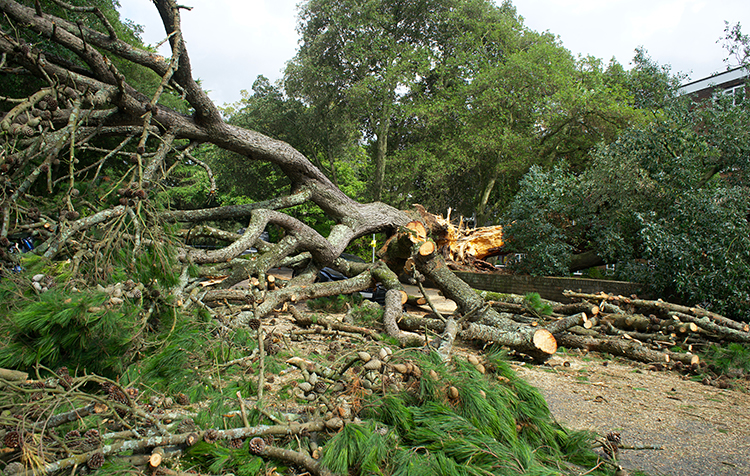Modern highways are utilitarian and aren’t generally designed as attractive thoroughfares lined with gorgeous trees. Yet, some highways do have their fair share of foliage, and more trees are being planted along highways to help the environment. Who takes care of and maintains these trees?
Trees: Beauty and Hazard
A tree-lined highway is both a beauty and a hazard. Trees are a wonderful addition to a landscape, and when healthy and properly maintained, they add visual attractiveness and serenity to any environment. Trees also offer an environmental benefit in that they eat up carbon dioxide, which is a global-warming gas. Trees also remove particulate pollution from the air. Therefore, more trees are generally better.
Trees can also present a hazard. As trees grow, they can shed leaves as well as branches, and if that tree debris falls onto a highway, it could potentially cause an automobile accident. Additionally, if a storm happens, the trees themselves could fall and block a thoroughfare.
Tree roots can also become a problem for roads and streets if allowed to grow and deform asphalt. While some of this root growth may be tolerable on slower, local roads, it can become hazardous for cars driving at fast speeds.
Because of the downsides of trees, they need to be properly maintained to keep highways safe and free of branches and limbs.
What Is the Difference Between Freeways and Highways?
To understand who takes care of trees on highways, we need to first clarify our terminology. The United States road system is somewhat complicated in terms of who manages what. Many of the definitions are overlapping and confusing to the average person. Let’s look at the difference between a freeway and a highway.
Freeways
A freeway is almost the same thing as a highway. It’s basically a restricted access road that allows for generally higher speed traffic without any tolls or stops. The lack of tolls is what makes a freeway a freeway. In other words, freeways are free. Freeways are also free of intersections, as well as pedestrians and other forms of non-automobile traffic. A freeway is a type of highway, but a highway is not a type of freeway.
Highways
The word “highway” is a broader term for a public-access thoroughfare that could potentially include tolls as well as intersections. However, highways allow for faster traffic than typical roads. Even highways with intersections may allow traffic up to 55 miles an hour or so, depending on the locality, although many localities are looking to move away from lights and intersections on their highways and transition into exit ramps instead.
Both freeways and highways often contain divided traffic. The single lane version of a highway will have cars on the right and cars on the left, but frequently, as the traffic needs of the area grow, you will find divided highways where the two lanes of traffic are separated by a median, or strip of ground in between the disparate traffic. These medians often include trees as part of the landscape.
Here’s another complication beyond just the difference between highways versus freeways in the United States: We also have interstates, which are highways that cross state lines. Interstate highways were generally built by the United States federal government but are now owned by the respective states where the portion of freeway was constructed. Each U.S. state also has state highways that are managed by the individual states. To further confuse things, you can also find U.S. highways that aren’t quite the same thing as federal interstates.
Many of these highways and freeways are overlapping in that there can be a transition between interstate and state highways that is often not so obvious to the person using the road.
Organizations Handling Highway Tree Care
So which organizations are responsible for coordinating and executing highway tree care and where is the funding allocated from?
The Federal Highway Administration
An agency within the U.S. Department of Transportation, — helps state and local governments in building and maintaining the American highway system via the Federal Aid Highway Program. Some of these highways also go through tribal-owned lands.
The FHWA has been around since October 15, 1966, and supports state and local governments with financial and technical assistance to ensure the safety and smooth operations of America’s highways.
State Highway Agencies
In addition to the FHWA, each state has its own agency or agencies responsible for maintaining highways and freeways. For example, Indiana has INDOT, the Indiana Department of Transportation. In Indiana, INDOT handles the roads, including federal interstates, U.S. highways and Indiana state roads, from construction to maintenance to traffic signals.
State highway maintenance operations can include everything from clearing snow in the winter to filling dangerous potholes. Managing vegetation such as trees is also a critical part of state highway maintenance operations.
Local Municipalities and Utility Companies
In addition to state and federal monies for maintaining highways, local municipalities and utility companies may need to manage tree growth along highways and freeways. Some of this management may depend on the exact boundaries of the highway versus the surrounding green area.
Tree Service Providers for Highways
For municipalities that need tree maintenance for local highways, a tree service provider like Townsend Tree Service can help. Proper tree management for highways includes more than just occasional pruning. It should include some strategic planning to anticipate potential problems and establish the best foliage maintenance programs.
With many states opting to add more trees to help with the environment, proper vegetation maintenance is a must.
Townsend Tree Service helps keep highways beautiful and free of dangerous tree debris through proactive vegetation management, power line clearance and
herbicide package and application. Our goal is to deliver results and solutions that improve safety for all.
Townsend Tree Service is a leading, multi-state provider of expert tree trimming, line clearing and vegetation management services. Our vast experience includes keeping highways free of tree debris. Learn more about our integrated vegetation management services here.
